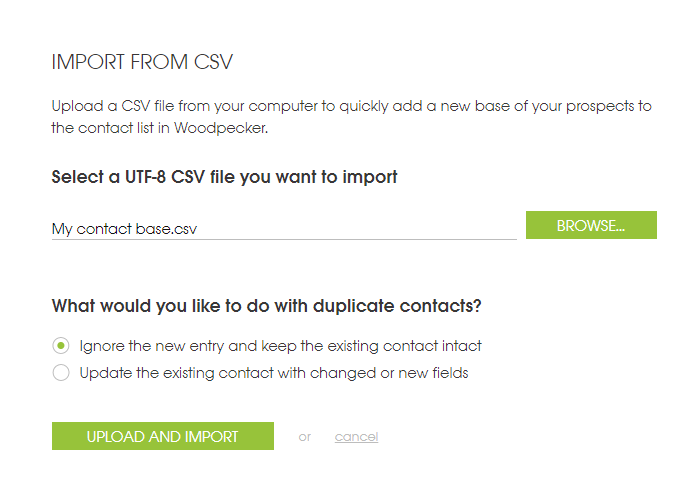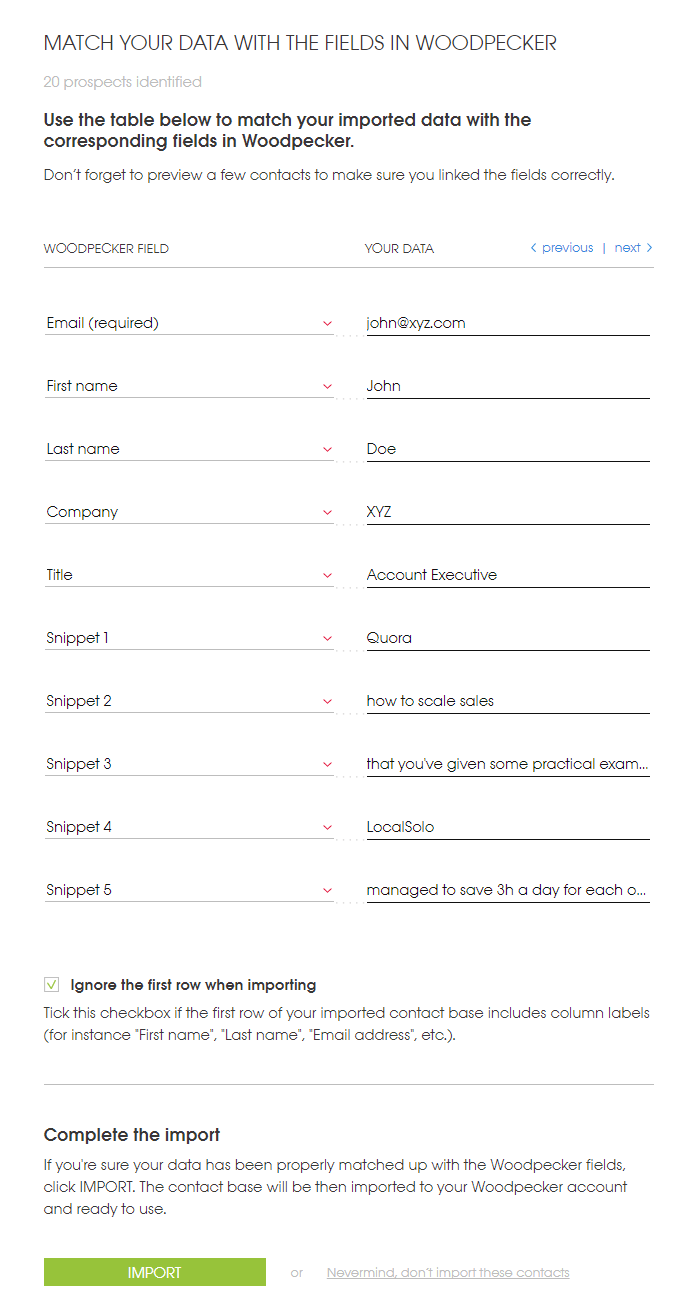What are mail merge custom fields, dynamic fields, or snippets? However you call them, these are just the pieces of information about each of your prospects that can be merged into your email templates to make your messages catch people’s attention. Oh, and one more thing – successful cold email outreach can’t be done without them.
In this post, I’m sharing some ideas for custom fields, other than the traditional first name and company name. Learn where to find them and how to add them to your prospect base for more effective personalization at scale.
Why are mail merge custom fields so important in cold email?
Basically, personalized emails show you’re a human being. And that’s crucial in automated outreach for at least two reasons:
#1 Potentially higher reply rates
If the emails show that you actually took some time to do some research, prepare the messages and send them, people start to pay attention. They pay even more attention when you talk about them instead of yourself, so they will be more eager to read your personalized emails and reply to them.
#2 Higher deliverability rates
If you use high-level personalization, each email looks different, even if they’re all based on the same email template. That gets such bulk emails delievered more often than generic, leaflet-like messages that are virtually identical.
Find out more about How Personalization Affects Cold Email Deliverability >>
A list of mail merge custom fields ideas
You probably know some basic snippets, like:
- First name,
- Company name,
- Website,
- Title,
- Industry,
- Country,
- City, etc.
Those are the most often used dynamic fields. But that’s not all you can merge into your messages.
Here’s a few more ideas:
The place where you found the prospect
This one is to prove to your recipient that you actually took some time to find them and their contact details. BUT: If you found them on LinkedIn, you won’t be very original, so that’s not the place you necessarily want to mention in your message.
Check 15 Places to Find Prospects, Other than LinkedIn >>
You can also mention here a list of award winners, a collection of tools best for XYZ, a specific topic from a forum where your prospect said something that has drawn your attention. For example:
(…) Yesterday I’ve read your answer on {{Quora}} about {{how to find and hire the best sales professionals}}.
The reason why you decided to reach out to them
This kind of sums up the purpose of all snippets. But you can deliberately and clearly state the reason why you chose your recipient, and not someone else, to contact. This is to show them that you’ve done some serious research and chosen them from hundreds or even thousands of other potential companies, because it made sense to connect and start a mutually beneficial business relation.
If you use this kind of a snippet, you’ll be the one to answer the question that usually pops up in their mind when they get a cold email: “why would a stranger send this to me?”
Usually, cold email senders who don’t personalize their messages don’t strive to answer this important question. And if there’s no logical connection between the message and the reason behind the message, the reply rates won’t get very impressive.
So, you could write, for example:
I’ve reviewed 50 companies from {{the software industry}} but decided to contact you because {{you had the most game projects in your portfolio, and games is the field we specialize in}}.
The title of their blog post
It all depends who you’re reaching out to, but if you’re trying to make some deals with bloggers, they will always pay attention when you refer to their work.
A little hint here, you don’t have to quote their blog post’s title. It sounds more natural if you shorten it, or paraphrase it a bit. Take for instance:
Looking for practical posts on cold emailing, I found your {{tutorial in 6 steps}}…
That catches the eye, as you present yourself as their blog reader who reaches out to them. You’re not a stranger anymore. You are their blog reader. And that makes a huge difference.
The part you liked most about their post/website
Another important hint – if you mention a specific post or article, it’s also crucial to tell your addresee what you appraciated the most in it, which part you found the most interesting, or which part has helped you the most.
Otherwise, it’s just “I’ve seen your post, it’s great” – which doesn’t really prove you actually read it or had a deeper interest in it.
If you’re able to prove to the prospect that what they wrote about actually got you interested, you may very quickly catch their attention.
Remember that influencers usually get tons of emails. To catch their eye, you need something more than: “I’m reading your blog. Great stuff.”
Refer to a chosen part of the article, for example:
… the part about {{adjusting the value proposition to a specific target group}} has really changed my perspective. I’m definitely trying this out.
If you reach out to bloggers with a business or partnership proposal, you don’t necessarily have to talk turkey right on. You may actually try to start a conversation first by asking them a question considering their article. This way, you can actually build a valuable relation which may last longer.
What they said/wrote about something related to your topic or offer
This one works best if you prospect on social platforms. You may find some people interested in the topic that your business revolves around or even in products or services similar to yours. Next, you can reach out to them via email and refer to what they’ve said.
You can quote their words, or paraphrase them. Plus, you can also combine it with the snippet that says what you liked most about their comment.
I used this approach when I was looking for influencers on Quora. It worked very well. You can read more about that in the post about How I Wrote a Cold Email that Got 50% Reply Rate >>
Another time, I found a site where Polish startups add descriptions of their businesses, plans for future growth, etc. Many of them mentioned that they were planning to expand their businesses by looking for customers abroad. I actually referred to the very words they wrote about that in my cold emails pitching Woodpecker. The campaign brought us some new customers then.
Mentions about your present clients who are similar to your prospects
Case studies are powerful. We remember about that when creating our websites. We add separate sections just to present our customers and build social proof. But we kind of forget about that power when writing our emails.
I often advise our users to mention their present customers in one of the follow-ups. If you have a case study or a testimonial from a company that is similar to the ones in your outbound prospect group, you can try to convince your prospects with a real-life example. This will allow them to build some additional context for your offer and it’ll help them identify themselves as your potential customers.
The difficult part is to make it sound as non-commercial as possible. Take for instance:
… we’ve been working with {{XYZ for over 6 months now}} and they’re seeing {{50% growth in the number of incoming leads}}. You can watch them telling about it here.
How to prepare the fields for mail merge?
I usually use a simple spreadsheet. I prepare the fields in the process of prospecting, and I put them as the names of my columns. Then, I list my prospects in the rows and collect all the necessary information about them in the form that will match my actual email copy.
I described the whole process in detail in this post:
What Should Go First: Cold Email Copy or Prospect Base? (free PDF) >>
Next, I save my spreadsheet as a .csv file, and I import it to Woodpecker.

I match my custom fields with the snippets in Woodpecker’s prospect base. There’s a list of default fields for mail merge (name, company, website, etc.), and additionally, 15 custom snippets to use.

Finally, I can preview all my emails before sending them, to make sure all the snippets perfectly match the email copy.
Once everything looks fine, I hit ‘Send’, and the presonalized emails get sent to my prospects automatically.
What’s in it for you?
I want you to remember that these are just a few ideas for a more creative approach to cold email personalization. That’s definitely not the whole list of what you can do. Actually, such a list doesn’t exist because there’s always a new approach to test and see if it brings better results.
Adding the default snippets, like the first name and company name, is better than no personalizaton at all, but if you really aim at high deliverability and satisfying reply rates nowadays, you need to go beyond that frame.
Again, an awful lot depends on your prospect group. If you’re aiming at a group that gets a lot of cold emails, you need to try very hard and get really original to grab their attention and get a reply from them.
And yes, collecting the info for the snippets takes time. But remember that you don’t need 500 prospects to start a campaign. Start small, take care of good quality, test and modify your campaigns to get satysfying results.
***
Curious to learn more? Watch our personalization webinar.
READ ALSO

How Does Personalization Affect Cold Email Deliverability?
I've already written a few pieces on personalization in cold email. I've given numerous reasons why personalization is a must. Yet, here's another one: deliverability of your cold email campaigns. This is something you can't just ignore or omit, because if you do – your emails will simply stop being sent. Here's more about the link between personalization and deliverability. Check how it works and how to personalize your cold email campaigns to make sure your emails get sent and delivered.

How to Write a Cold Email that Actually Works in 6 Steps (2024)
To get replies, a cold email has to be short yet powerful, and intriguing. That's why each part of this short message has to bear meaning and play a crucial communicative role. Check if you know these 6 tremendously important steps to write a cold email for sales that works.

What Should I Learn About a Company Before Sending Them a B2B Sales Email?
This is a piece inspired by a very good question I've come across on Quora. It will be especially helpful to those of you who either prepare to start their first sales email copy, or they've been sending cold emails that don't bring the desired effects.
